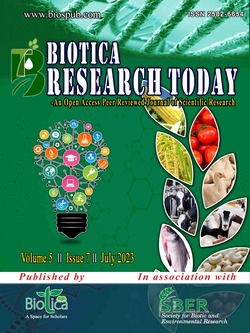
BDR 10: Yellow Larval Daba Bivoltine Race of Tropical Tasar Silkworm, Antheraea mylitta D. (Lepidoptera: Saturniidae)
Sangeeta Dash
Division of Entomology, ICAR-Indian Agricultural Research Institute, Pusa Campus, New Delhi (110 012), India
DOI: NIL
Keywords: BDR 10, Bivoltine, Daba, Tasar silkworm
Abstract
Tasar silkworm, Antheraea mylitta, is an economically important serigenous insect. The tasar silk industry sustains livelihood of many rural tribal families across the tasar belt of the country. Commercially important tasar ecoraces are Daba and Sukinda. In 2018, new Daba bivoltine race BDR 10 of yellow larval type was authorised. Multilocation trials across the country have proved the superiority of BDR 10 over Daba bivoltine (DBV). BDR 10 have better commercial cocoon characters and viral resistance as compared to DBV. Thus, the present review deals with various aspects of tasar silk worm and stress the need to popularise the new race among the farmers and stakeholders of the tasar sericulture.
Downloads
not found
Reference
Chandrashekharaiah, M., Rathore, M.S., Hasansab, N., Vishaka, G.V., Srinivas, C., 2021. BDR-10, a newly authorized tropical tasar silkworm race: Its maintenance, mass multiplication and popularization in India. Indian Entomologist 2(1), 78-84.
Chandrashekharaiah, M., Rathore, M.S., Sinha, R.B., 2019. Performance of BDR-10: A newly authorized race of Antheraea mylitta D. in different agro climatic zones in India. Journal of Pharmacognosy and Phytochemistry 8(6), 274-277.
Renuka, G., Shamitha, G., 2016. Genetic variation in ecoraces of tropical tasar silkworm, Antheraea mylitta using SSR markers. Journal of Genetics 95(4), 777-785. DOI: https://doi.org/10.1007/s12041-016-0712-4.
Saha, M., Kundu, S.C., 2006. Molecular identification of tropical tasar silkworm (Antheraea mylitta) ecoraces with RAPD and SCAR markers. Biochemical Genetics 44(1-2), 72-85. DOI: https://doi.org/10.1007/s10528-006-9007-4.
Sinha, A.K., 2011. Variability in the ecoraces of tropical tasar sillkworm Antheraea mylitta drury. Nature Proceedings 2011. DOI: https://doi.org/10.1038/npre.2011.6161.1.
